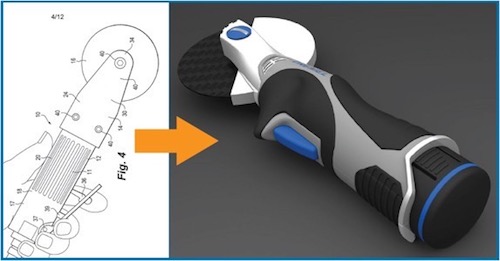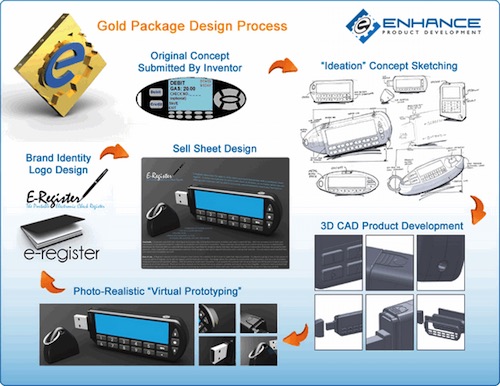 If you are going to file a patent application you must have drawings to include in the application, but patent drawings are not the only type of “drawings” that an inventor should be considering. Patent drawings are wonderful for a patent application, but they don’t always do the invention justice if you are trying to capture the attention of a prospective licensee, or if you are trying to convince a buyer to place orders or sell the invention in their store.
If you are going to file a patent application you must have drawings to include in the application, but patent drawings are not the only type of “drawings” that an inventor should be considering. Patent drawings are wonderful for a patent application, but they don’t always do the invention justice if you are trying to capture the attention of a prospective licensee, or if you are trying to convince a buyer to place orders or sell the invention in their store.
Simply stated, patent drawings and other types of invention drawings, such as 3D renderings and photo realistic virtual prototypes serve different purposes. For example, take a look at the figure below, provided courtesy of Enhance Innovations a product development company with a great deal of experience licensing and developing products in consumer markets. The patent illustration is on the left, and a branded, photo realistic virtual prototype is shown on the right. Which do you think would better capture the attention of a prospective licensee?

Of course, the patent drawing contains reference numerals that are used by the patent attorney in the Detailed Description of the patent application, and this is a perfectly fine illustration to include in a patent application. But remember, the point of the Detailed Description is to describe what is shown in the figures (at a minimum). This is done in writing as if the reader is standing next to you as you describe what the figure shows. You use the reference numerals to draw the attention of the reader to the part of the figure you are discussing at any given time. That, however, is noise when you are trying to capture the attention of a prospective licensee. What you need and want is something that allows the person you are pitching to quickly and easily envision the product as it will be sold. As necessary as patent drawings are they simply do not capture the consumer product with nearly the same impact as a 3D rendering does.
With patent drawings you can show exploded views (see figure below) that allow you to show how the pieces and parts fit together. This enables the patent attorney to describe how to make the invention step by step, which is not only a good idea but a requirement for any patent application. Of course, such exploded views invariably focus on the internal, not the external. Will a prospective licensee really be concerned, at least in the first instance, about the internal workings? A prospective licensee will no doubt want to know about the internal workings and how everything is put together, but that comes only after you have captured their attention and they are ready, willing and interested to learn more. So in the first instance a 3D rendering or photo realistic virtual prototype is far more likely to capture the attention of the prospective licensee. You want to grab them with a compelling visual presentation of a real and tangible product. Once they are interested you can go deeper.

Taken from U.S. Patent No. 5,839,263, which relates to a lawn mower blade with replacement knives.
A patent applicant is required* to furnish at least one patent drawing (sometimes referred to as a patent illustration) of the invention whenever the invention is capable of illustration by way of a drawing. Said another way, whenever a drawing would assist in the understanding of an invention you need at least one patent drawing. Based on my experience I can say that a patent drawing is almost always required, and even if it is not technically required you should have at least one patent drawing. Why take the chance that the patent examiner will require patent drawings? If you need a patent drawing and one is not provided in the original filing a non-provisional patent application you are not even awarded a filing date, which can be catastrophic. Thus, I urge inventors to understand the patent drawing requirement in this way: The only time patent drawings are not required is when the invention relates to a chemical compound, composition or a method.
In my opinion it is always better to be safe than sorry with drawings. That is why I always advocate for filing patent applications with more drawings. Drawings are not free, but they do not cost very much given the overall cost of filing for and obtaining a patent. I think most applications include too few drawings. It is, therefore, advisable to file with multiple drawings. For more on working with patent drawings see Patent Drawings 101: The Way to Better Patent Applications.
Detailed drawings are indeed worth one thousand words, if not more. This is true because if you accidentally leave something out of the written disclosure, a drawing you submit may save you in the long run, provided of course it is detailed enough to convey nuanced information about your invention. Because the detail of the patent drawing is what saves you, having a professional patent illustrator is quite wise. Without question, the best way to broaden the scope of any application is to file the application with multiple, detailed and professional drawings. The benefit received from professional patent illustration is well worth the investment.
So you should rush off to a patent illustrator and get your invention illustrated with numerous drawings showing a variety of views from different vantage points, right? To quote Lee Corso of ESPN College Football Gameday fame – Not so fast my friend!
What if you could get initial illustrations that can be used for multiple different purposes? That would make the most sense because it is more economical, and you can if you work with someone that does 3D rendering.
According to Mike Store, an Industrial Designer with Enhance Innovations, “The reality is that completing product development, through design, engineering, tooling, etc. is very expensive and isn’t feasible for the average inventor with a great idea. Our services seek to key in on developing a feasible product by fleshing it out with the inventor, designing it in CAD.” In fact, if you look at the image below which shows the Enhance process, Enhance starts with the inventor concept and moves on to concept sketching before engaging in 3D CAD product development.

From the 3D CAD renderings a photo realistic virtual prototype is created, which can then be branded and added to the sell sheet. By following this process the 3D CAD renderings can be output as line drawings that make exceptionally good patent drawings, at least for a provisional patent application where the focus is disclosure. The Patent Office will never examine a provisional patent application, so none of the picky patent drawing rules will be enforced against provisional patent drawings. Therefore, you just need to have quality line drawings for a provisional patent application. Once the 3D CAD renderings are done as many drawings as you want can be output, from various rotated viewpoints, as well as a variety of close-up views.
True, patent drawings must show every feature of the invention specified in the claims, and for a non-provisional patent application they are required to be in a particular form. The Patent Office specifies the size of the drawing sheet on which the illustration is made, the type of paper, the margins, and many other hyper-technical details relating to the making of the drawings, including shading and size of text if present. The reason for specifying the standards in detail is that the drawings are printed and published in a uniform style when the patent issues, and the drawings must also be such that they can be readily understood by persons using the patent descriptions. But none of these rules apply to provisional patent drawings, and the focus of a provisional patent application is to demonstrate the entirety of the invention. What better way to do that than with numerous drawings that have been output after a 3D CAD rendering? Thus, the 3D CAD rendering becomes for focal point for allowing the inventor to obtain all of the types of illustrations they will need initially.
As you move forward to the photo realistic virtual prototyping, which is anywhere from 10 to 100 times cheaper than developing a single real-world prototype, the creation of the “sell sheet” becomes critical for those who are looking to license their invention. Trevor Lambert, President of Lambert & Lambert, a group of licensing specialists that work on a contingency basis, explains:
Our sell sheets feature the product design developed through 3D CAD software with large photo-realistic rendered images of the product. Commonly we will even brand the product with the potential licensee’s brand, so each sell sheet is tailored for a specific licensee. This allows the decision makers to visualize what the product would look like fully developed under their product line. This becomes a powerful sales tool and something I refer to as a “psychological bridge” that we have found greatly improves the license success rate.
With your invention the ultimate goal is to make money. To make money requires one to spend money, but you absolutely have to do that wisely so that you do not run out of funds halfway through a project. Inventors need to create a budget and do the most they can with the money they have to spend. If your goal is to attract a licensing deal you need to make your invention as real as possible. Creating a virtual prototype that can be added to a sell sheet and circulated is definitely a winning strategy. The fact that the steps toward that strategy will give you a plethora of patent drawings to include in a provisional patent filing is a bonus! After all, you are likely going to need to file the provisional patent application in order to take the first steps toward securing exclusive rights. That way you have something tangible to license in terms of visual presentation and in terms of intellectual property protection.
Happy inventing!
_______
* Starting December 18, 2013, it is now possible to obtain a filing date on a nonprovisional patent application without a drawing being present at the time of filing. This new rule does not change the reality that at least a single drawing is required when necessary. Thus, filing an application without a drawing is enormously risky and should be avoided. A drawing is worth a thousand words, if not more. If you try and add a drawing after filing you will almost certainly be prevented from doing so because despite the fact that a drawing is not required to get a filing date you still cannot add new matter after you file a patent application. Adding drawings will ordinarily add material, which is absolutely prohibited. The Patent Office has cautioned applicants that it remains best practice to file with drawings.

![[IPWatchdog Logo]](https://ipwatchdog.com/wp-content/themes/IPWatchdog%20-%202023/assets/images/temp/logo-small@2x.png)

![[[Advertisement]]](https://ipwatchdog.com/wp-content/uploads/2018/10/Enhance-2-IPWatchdog-Ad-2499x833-2.png)
![[[Advertisement]]](https://ipwatchdog.com/wp-content/uploads/2018/08/Ad-1-The-Invent-Patent-System™-1.png)
![[[Advertisement]]](https://ipwatchdog.com/wp-content/uploads/2018/10/ip-ad_rocket_464.jpeg)
![[Advertisement]](https://ipwatchdog.com/wp-content/uploads/2024/04/Patent-Litigation-Masters-2024-sidebar-early-bird-ends-Apr-21-last-chance-700x500-1.jpg)

![[Advertisement]](https://ipwatchdog.com/wp-content/uploads/2021/12/WEBINAR-336-x-280-px.png)
![[Advertisement]](https://ipwatchdog.com/wp-content/uploads/2021/12/2021-Patent-Practice-on-Demand-recorded-Feb-2021-336-x-280.jpg)
![[Advertisement]](https://ipwatchdog.com/wp-content/uploads/2021/12/Ad-4-The-Invent-Patent-System™.png)







Join the Discussion
2 comments so far.
Suzanne
June 13, 2015 09:01 pmVery important points to keep entrepreneurs from falling victim to patent trolls – great post!
Anon
May 30, 2015 09:13 amThe “when necessary” caveat – to me – seems an artifice that is as often overplayed as the request for divisionals.
As I find myself more and more telling my children, there is a very important difference between “want” and “need.”